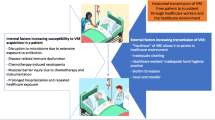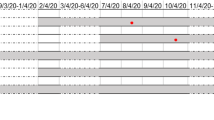Abstract
Increasing colonization and infection with vancomycin-resistant enterococci (VRE) in immunocompromised patients are associated with increased mortality. Despite contact precautions for VRE control, rapid limitation of its spread is often impossible. We report on a VRE outbreak in a hematologic/oncologic unit including 33 patients. Although 28 of the patients had only VRE colonization, VRE-related infection was probable in 4 patients, and VRE infection of the bloodstream occurred in 1 case. Two patients were identified by VRE screening on admission, 20 were identified by weekly routine VRE screening, and 6 were identified from specimens taken to clarify infections (eg, urine, bronchoalveolar lavage). Five individuals acquired VRE colonization as inpatients (contact patients). Multiple-locus variable-number tandem repeat analysis (MLVA) proved that the outbreak was caused byVanA gene-positiveEnterococcus faecium belonging to MLVA genogroup C1 (MLVA types 1,7,12). The outbreak strains exhibited the potential virulence factoresp (enterococcus surface protein). The outbreak was terminated within 2 months by intensified infection-control measures, including quarantine and the cohorting of patients who tested positive for VRE; however, VRE spread recurred after the measures were discontinued but was again limited by resuming the measures. We conclude that intensive infection-control strategies enable the timely termination of VRE outbreaks, even those involving VRE strains with high epidemic potential on “high-risk wards” (eg, hematologic/oncologic units). Premature discontinuation of infection-control measures may cause recurrence of the VRE spread.
Similar content being viewed by others
References
DiazGranados CA, Jernigan JA. Impact of vancomycin resistance on mortality among patients with neutropenia and enterococcal bloodstream infection.J Infect Dis. 2005;191:588–595.
DiazGranados CA, Zimmer SM, Klein M, Jernigan JA. Comparison of mortality associated with vancomycin-resistant and vancomycin-susceptible enterococcal bloodstream infections: a meta-analysis.Clin Infect Dis. 2005;41:327–333.
Knoll M, Daeschlein G, Okpara-Hofmann J, et al. Outbreak of vancomycin-resistant enterococci (VRE) in a hematological oncology ward and hygienic preventive measures: a long-term study.Onkologie. 2005;28:187–192.
Murray BE. Vancomycin-resistant enterococcal infections.N Engl J. Med. 2000;342:710–721.
Low DE, Keller N, Barth A, Jones RN. Clinical prevalence, antimicrobial susceptibility, and geographic resistance patterns of enterococci: results from the SENTRY Antimicrobial Surveillance Program, 1997–1999.Clin Infect Dis. 2001;32(suppl 2):S133-S145.
Patel R. Clinical impact of vancomycin-resistant enterococci.J Antimicrob Chemother. 2003;51(suppl 3):13–21.
Bonten MJ, Hayden MK, Nathan C, et al. Epidemiology of colonisation of patients and environment with vancomycin-resistant enterococci.Lancet. 1996;348:1615–1619.
Boneca IG, Chiosis G. Vancomycin resistance: occurrence, mechanisms and strategies to combat it.Expert Opin Ther Targets. 2003;7:311–328.
Padiglione AA, Wolfe R, Grabsch EA, et al. Risk factors for new detection of vancomycin-resistant enterococci in acute-care hospitals that employ strict infection control procedures.Antimicrob Agents Chemother. 2003;47:2492–2498.
Lee TA, Hacek DM, Stroupe KT, Collins SM, Peterson LR. Three surveillance strategies for vancomycin-resistant enterococci in hospitalized patients: detection of colonization efficiency and a cost-effectiveness model.Infect Control Hosp Epidemiol. 2005;26:39–46.
Price CS, Paule S, Noskin GA, Peterson LR. Active surveillance reduces the incidence of vancomycin-resistant enterococcal bacteremia.Clin Infect Dis. 2003;37:921–928.
Scagnelli M, Pellizer G, de LallaF, et al. Epidemiological analysis of vancomycin-resistant enterococci in a large tertiary-care hospital in Northern Italy.Eur J Clin Microbiol Infect Dis. 2001;20:609–616.
Kauffman CA. Therapeutic and preventative options for the management of vancomycin-resistant enterococcal infections.JAntimicrob Chemother. 2003;51(suppl 3):23–30.
Mascini EM, Bonten MJ. Vancomycin-resistant enterococci: consequences for therapy and infection control.Clin Microbiol Infect. 2005;11(suppl 4):43–56.
National Committee for Clinical Laboratory Standards. Performance standards for antimicrobial susceptibility testing: 12th informational supplement. Approved standard M100-S12. Wayne, Pa: National Committee for Clinical Laboratory Standards; 2002.
Klare I, Konstabel C, Mueller-Bertling S, et al. Spread of ampicillin/vancomycin-resistantEnterococcus faecium of the epidemic-virulent clonal complex-17 carrying the genesesp andhyl in German hospitals.Eur J Clin Microbiol Infect Dis. 2005;24:815–825.
Top J, Schouls LM, Bonten MJ, Willems RJ. Multiple-locus variable-number tandem repeat analysis, a novel ty** scheme to study the genetic relatedness and epidemiology ofEnterococcus faecium isolates.J Clin Microbiol. 2004;42:4503–4511.
Leavis H, Top J, Shankar N, et al. A novel putative enterococcal pathogenicity island linked to the esp virulence gene ofEnterococcus faecium and associated with epidemicity.J Bacteriol. 2004;186:672–682.
Toledo-Arana A, Valle J, Solano C, et al. The enterococcal surface protein, Esp, is involved inEnterococcus faecalis biofilm formation.Appl Environ Microbiol. 2001;67:4538–4545.
Shankar V, Baghdayan AS, Huycke MM, Lindahl G, Gilmore MS. Infection-derivedEnterococcus faecalis strains are enriched inesp, a gene encoding a novel surface protein.Infect Immun. 1999;67:193–200.
Eaton TJ, Gasson MJ. A variant enterococcal surface protein Espfm inEnterococcus faecium: distribution among food, commensal, medical, and environmental isolates.FEMS Microbiol Lett. 2002;216:269–275.
Armeanu E, Bonten MJ. Control of vancomycin-resistant enterococci: one size fits all?Clin Infect Dis. 2005;41:210–216.
Doebbeling BN, Pfaller MA, Houston AK, Wenzel RP. Removal of nosocomial pathogens from the contaminated glove: implications for glove reuse and handwashing.Ann Intern Med. 1988;109:394–398.
Yoo JH, Lee DG, Choi SM, et al. Vancomycin-resistant enterococcal bacteremia in a hematology unit: molecular epidemiology and analysis of clinical course.J Korean Med Sci. 2005;20:169–176.
Ostrowsky BE, Trick WE, Sohn AH, et al. Control of vancomycin- resistant enterococcus in health care facilities in a region.N Engl J Med. 2001;344:1427–1433.
Hachem R, Graviss L, Hanna H, et al. Impact of surveillance for vancomycin-resistant enterococci on controlling a bloodstream outbreak among patients with hematologic malignancy.Infect Control Hosp Epidemiol. 2004;25:391–394.
Bonora MG, Ligozzi M, De Fatima M, et al. Vancomycin-resistantEnterococcus faecium isolates causing hospital outbreaks in northern Italy belong to the multilocus sequence ty** C1 lineage.Microb Drug Resist. 2004;10:114–123.
Stampone L, Del Grosso M, Boccia D, Pantosti A. Clonal spread of a vancomycin-resistantEnterococcus faecium strain among bloodstream-infecting isolates in Italy.J Clin Microbiol. 2005;43:1575–1580.
Author information
Authors and Affiliations
Corresponding author
About this article
Cite this article
Schmidt-Hieber, M., Blau, I.W., Schwartz, S. et al. Intensified Strategies to Control Vancomycin-Resistant Enterococci in Immunocompromised Patients. Int J Hematol 86, 158–162 (2007). https://doi.org/10.1532/IJH97.E0632
Received:
Revised:
Accepted:
Published:
Issue Date:
DOI: https://doi.org/10.1532/IJH97.E0632




